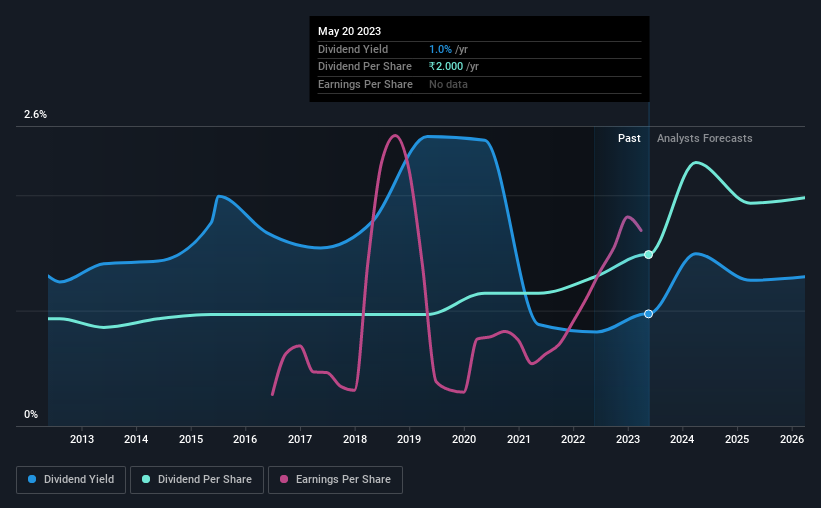- India
- /
- Electric Utilities
- /
- NSEI:TATAPOWER
Tata Power's (NSE:TATAPOWER) Upcoming Dividend Will Be Larger Than Last Year's

The Tata Power Company Limited's (NSE:TATAPOWER) dividend will be increasing from last year's payment of the same period to ₹2.00 on 19th of July. Although the dividend is now higher, the yield is only 1.0%, which is below the industry average.
See our latest analysis for Tata Power
Tata Power's Earnings Easily Cover The Distributions
Even a low dividend yield can be attractive if it is sustained for years on end. Tata Power is quite easily earning enough to cover the dividend, however it is being let down by weak cash flows. We think that cash flows should take priority over earnings, so this is definitely a worry for the dividend going forward.
Looking forward, earnings per share is forecast to fall by 18.5% over the next year. If the dividend continues along the path it has been on recently, we estimate the payout ratio could be 25%, which is comfortable for the company to continue in the future.

Tata Power Has A Solid Track Record
Even over a long history of paying dividends, the company's distributions have been remarkably stable. Since 2013, the dividend has gone from ₹1.25 total annually to ₹2.00. This implies that the company grew its distributions at a yearly rate of about 4.8% over that duration. Dividends have grown relatively slowly, which is not great, but some investors may value the relative consistency of the dividend.
Dividend Growth May Be Hard To Achieve
The company's investors will be pleased to have been receiving dividend income for some time. Earnings has been rising at 3.6% per annum over the last five years, which admittedly is a bit slow. While EPS growth is quite low, Tata Power has the option to increase the payout ratio to return more cash to shareholders.
Our Thoughts On Tata Power's Dividend
Overall, this is probably not a great income stock, even though the dividend is being raised at the moment. While the low payout ratio is a redeeming feature, this is offset by the minimal cash to cover the payments. We would be a touch cautious of relying on this stock primarily for the dividend income.
It's important to note that companies having a consistent dividend policy will generate greater investor confidence than those having an erratic one. Meanwhile, despite the importance of dividend payments, they are not the only factors our readers should know when assessing a company. Just as an example, we've come across 2 warning signs for Tata Power you should be aware of, and 1 of them is potentially serious. Looking for more high-yielding dividend ideas? Try our collection of strong dividend payers.
Valuation is complex, but we're here to simplify it.
Discover if Tata Power might be undervalued or overvalued with our detailed analysis, featuring fair value estimates, potential risks, dividends, insider trades, and its financial condition.
Access Free AnalysisHave feedback on this article? Concerned about the content? Get in touch with us directly. Alternatively, email editorial-team (at) simplywallst.com.
This article by Simply Wall St is general in nature. We provide commentary based on historical data and analyst forecasts only using an unbiased methodology and our articles are not intended to be financial advice. It does not constitute a recommendation to buy or sell any stock, and does not take account of your objectives, or your financial situation. We aim to bring you long-term focused analysis driven by fundamental data. Note that our analysis may not factor in the latest price-sensitive company announcements or qualitative material. Simply Wall St has no position in any stocks mentioned.
About NSEI:TATAPOWER
Tata Power
Engages in the generation, transmission, distribution, and trading of electricity in India and internationally.
Average dividend payer with acceptable track record.


